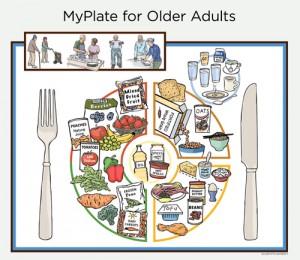By Elizabeth Costello, MPH, JSI | Project Manager, MA Healthy Aging Collaborative website
Most of us know the healthy diet drill by now: Eat more fruits, vegetables, and whole grains, and less sugar, sodium, and saturated fat. But if you have been avoiding eggs in order to limit your cholesterol intake, you may be interested in the recent advisory report of the 2015 Dietary Guidelines Advisory Committee, which suggests that within the context of current intake levels, dietary cholesterol is no longer a “nutrient of concern” for overconsumption. However, this does not mean you can eat all the eggs you want – one a day or two every other day is fine.
Every five years, the U.S. Department of Health and Human Services (HHS) and the U.S. Department of Agriculture (USDA) release updated dietary guidelines for Americans. The Advisory Committee is a group of outside experts in nutrition, medicine, and public health charged with reviewing the current science and providing HHS and USDA with a summary of the evidence to consider in making their final recommendations for 2015.
I recently spoke with Dr. Alice H. Lichtenstein, DSc, who was Vice Chair of the Advisory Committee and is Gershoff Professor of Nutrition Science and Policy at Tufts University, about what the report may mean for older adults. First she points out that we will not know what the 2015 Dietary Guidelines will be until the end of this year, when the USDA and HHS release them. While she does not know what the final guidelines will be, in terms of overall dietary patterns, she does not think there will be big changes, especially for older adults that are relatively healthy and independent.
The dietary pattern that the advisory committee identified as most supported by the evidence was one rich in vegetables, fruits, whole grains, low- or non-fat dairy, seafood, legumes, and nuts; moderate in alcohol (among adults); lower in red and processed meat; and low in sugar sweetened foods and drinks and refined grains. “This pattern is flexible enough so that it can be adapted to personal preferences and ethnic and cultural traditions,” said Dr. Lichtenstein. “This is a dietary pattern that someone should be able to follow throughout their life, [and] that includes older adults.” One good part of adopting the pattern is to opt for vegetable fats over animal fats and avoid low-fat, high-sugar foods as replacements.
Dr. Lichtenstein said that as people age and their health status changes (e.g., developing hypertension or type 2 diabetes) they may have to make small changes to their diets, such as being more vigilant about total calories or sodium intake. This may mean cutting back on portion sizes and cooking a bit more at home, since most sodium comes from processed foods. But given that biological aging is different for everyone, each person may need to modify their diet at a different time in their lives and in different ways based on their own health status. If healthy eating and physical activity habits are developed early, she indicated there may be no need to change at all. She did emphasize that everybody should be enjoying the foods they consume throughout their life span, and customizing the recommendations to their own tastes, which are established early on.
I really enjoy eggs for breakfast, without a side of bacon or sausages, so I was excited to ask Dr. Lichtenstein about the shift in messaging around dietary cholesterol. I also have blood cholesterol levels in the normal range. The report indicated that the available evidence “shows no appreciable relationship between consumption of dietary cholesterol and serum cholesterol.” However, she emphasizes that this finding should be viewed within the context of current intake levels, and does not mean that people should eat an unlimited amount of eggs. If people start increasing their egg intake dramatically there is the possibility that they will increase their risk for cardiovascular disease, partially those who are currently being treated by their physicians. She emphasizes everything in moderation and to check with your healthcare provider if you decide to make a major change in your diet.
We also talked about some of the challenges older adults may have in adopting a healthier dietary pattern. “One of the things we addressed [in the report] is behavior change, hoping that some attention when the guidelines are released is given to the barriers for adhering to the guidelines,” said Dr. Lichtenstein. For example, if older adults are having a hard time incorporating enough fruits and vegetables in their diet, she recommended frozen produce for its value, convenience, and nutritional quality.
Dr. Lichtenstein is also director of the Cardiovascular Nutrition Laboratory and a senior scientist at the Jean Mayer USDA Human Nutrition Research Center at Tufts University, which developed My Plate for Older Adults. This visual resource aligns with the USDA’s My Plate food icon, which prompts people to think about building a healthy plate at mealtimes, but helps older adults to consider their unique physical activity and nutrition needs.
Consider how you can be creative in sharing nutrition information with the older adults you work with and helping them make a plan to modify their diet and meet the guidelines.
Do you have a go-to resource for communicating nutrition information to the older adults you work with? Do you have questions about the advisory report? Share your thoughts in the comments below.

